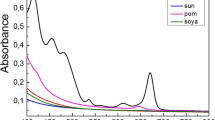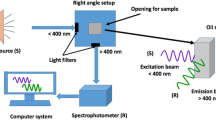Abstract
Extra virgin olive oil (EVOO) contains a higher ratio of antioxidants and monounsaturated fatty acids, and the price of EVOO is higher than that of other vegetable oils due to the complicated production process and storage condition. Adulteration of extra virgin olive oils with inferior vegetable oils has attracted increasing attentions. In this paper, we detect and quantify adulteration of extra virgin olive oil by 473 nm laser-induced fluorescence (LIF) with the help of multivariate analysis. Two hundred eighty sets of data are successfully classified to four groups (including olive, rapeseed, peanut, and blend oils). Moreover, a partial least squares model is built to predict the adulteration concentration with the errors lower than 2 %. The detection system will be assembled into a module (110 × 100× 25 mm). Due to non-destructive and requiring no sample pre-treatment characteristic, this method can be effectively employed for food safety detection.





Similar content being viewed by others
References
Cabanac RA, de Lapparent V, Hickson P (2002) Classification and redshift estimation by principal component analysis. Astron Astrophys 389:1090–1116
Christodouleas D, Fotakis C, Papadopoulos K, Dimotikali D, Calokerinos AC (2012) Luminescent methods in the analysis of untreated edible oils. A review. Anal Lett 45:625–641
Cosio MS, Ballabio D, Benedetti S, Gigliotti C (2006) Geographical origin and authentication of extra virgin olive oils by an electronic nose in combination with artificial neural networks. Anal Chim Acta 567:202–210
Fang GH, Goh JY, Tay M, Lau HF, Li SFY (2013) Characterization of oils and fats by H-1 NMR and GC/MS fingerprinting: classification, prediction and detection of adulteration. Food Chem 138:1461–1469
Gao L, Li XB (2015) Utilizing partial least square and support vector machine for TBM penetration rate prediction in hard rock conditions. J Cent South Univ 22:290–295
Guimet F, Ferre J, Boque R (2005) Rapid detection of olive-pomace oil adulteration in extra virgin olive oils from the protected denomination of origin “Siurana” using excitation-emission fluorescence spectroscopy and three-way methods of analysis. Anal Chim Acta 544:143–152
James D, Scott SM, O’Hare WT, Ali Z, Rowell FJ (2004) Classification of fresh edible oils using a coated piezoelectric sensor array-based electronic nose with soft computing approach for pattern recognition. T I Meas Control 26:3–18
Kadiroglu P, Korel F, Tokatli F (2011) Classification of turkish extra virgin olive oils by a SAW detector electronic nose. J Am Oil Chem Soc 88:639–645
Lerma-Garcia MJ, Ramis-Ramos G, Herrero-Martinez JM, Simo-Alfonso EF (2010) Authentication of extra virgin olive oils by Fourier-transform infrared spectroscopy. Food Chem 118:78–83
Man YBC, Abidin SZ, Rohman A (2011) Discriminant analysis of selected edible fats and oils and those in biscuit formulation using FTIR spectroscopy. Food Anal Method 4:404–409
Mansor TST, Man YBC, Rohman A (2011) Application of fast gas chromatography and Fourier transform infrared spectroscopy for analysis of lard adulteration in virgin coconut oil. Food Anal Method 4:365–372
Martin YG, Pavon JLP, Cordero BM, Pinto CG (1999) Classification of vegetable oils by linear discriminant analysis of electronic nose data. Anal Chim Acta 384:83–94
Mignani AG et al (2011) Visible and near-infrared absorption spectroscopy by an integrating sphere and optical fibers for quantifying and discriminating the adulteration of extra virgin olive oil from Tuscany. Anal Bioanal Chem 399:1315–1324
Mildner-Szkudlarz S, Jelen HH (2010) Detection of olive oil adulteration with rapeseed and sunflower oils using mos electronic nose and Smpe-Ms. J Food Quality 33:21–41
Mu TT, Chen SY, Zhang YC, Guo P, Chen H, Liu XH, Ge XY (2013) Classification of edible oils using 532 nm laser-induced fluorescence combined with support vector machine. Anal Methods-Uk 5:6960–6963
Mu TT, Chen SY, Zhang YC, Chen H, Guo P (2014) Analyzing fluorophore electronic structure and depolarization by fluorescence polarizing angle spectrum. Appl Phys Lett 105
Mu T, Chen S, Zhang Y, Guo P, Chen H (2015) Determining the orientation of transition moments and depolarization by fluorescence polarizing angle spectrum. Opt Express 23:11748–11754
Ntakatsane MP, Liu XM, Zhou P (2013) Short communication: rapid detection of milk fat adulteration with vegetable oil by fluorescence spectroscopy. J Dairy Sci 96:2130–2136
Oliveros MCC, Pavon JLP, Pinto CG, Laespada MEF, Cordero BM, Forina M (2002) Electronic nose based on metal oxide semiconductor sensors as a fast alternative for the detection of adulteration of virgin olive oils. Anal Chim Acta 459:219–228
Poulli KI, Mousdis GA, Georgiou CA (2005) Classification of edible and lampante virgin olive oil based on synchronous fluorescence and total luminescence spectroscopy. Anal Chim Acta 542:151–156
Poulli KI, Mousdis GA, Georgiou CA (2006) Synchronous fluorescence spectroscopy for quantitative determination of virgin olive oil adulteration with sunflower oil. Anal Bioanal Chem 386:1571–1575
Salghi R, Armbruster W, Schwack W (2014) Detection of argan oil adulteration with vegetable oils by high-performance liquid chromatography-evaporative light scattering detection. Food Chem 153:387–392
Samyn P, Van Nieuwkerke D, Schoukens G, Vonck L, Stanssens D, Van den Abbeele H (2012) Quality and statistical classification of brazilian vegetable oils using mid-infrared and raman spectroscopy. Appl Spectrosc 66:552–565
Sikorska E, Romaniuk A, Khmelinskii IV, Herance R, Bourdelande JL, Sikorski M, Koziol J (2004) Characterization of edible oils using total luminescence spectroscopy. J Fluoresc 14:25–35
Szymczyk P, Szymczyk M (2015) Supervised learning Laplace transform artificial neural networks and using it for automatic classification of geological structure. Neurocomputing 154:70–76
Troya F, Lerma-Garcia MJ, Herrero-Martinez JM, Simo-Alfonso EF (2015) Classification of vegetable oils according to their botanical origin using n-alkane profiles established by GC-MS. Food Chem 167:36–39
Woodbury SE, Evershed RP, Rossell JB, Griffith RE, Farnell P (1995) Detection of vegetable oil adulteration using gas-chromatography combustion isotope ratio mass-spectrometry. Anal Chem 67:2685–2690
Zhang ZE, Yan YF, Zhang L, Ju SX (2014) Hollow fiber membrane contactor absorption of Co2 from the flue gas: review and perspective. Global Nest J 16:354–373
Compliance with Ethical Standards
Funding
This study was funded by the National Natural Science Foundation of China (no. 61178072).
Conflict of Interest
Taotao Mu declares that he has no conflict of interest. Siying Chen declares that she has no conflict of interest. Yinchao Zhang declares that he has no conflict of interest. He Chen declares that he has no conflict of interest. Pan Guo declares that he has no conflict of interest.
Ethical approval
This article does not contain any studies with human participants or animals performed by any of the authors.
Informed consent
Informed consent was obtained from all individual participants included in the study.
Author information
Authors and Affiliations
Corresponding author
Rights and permissions
About this article
Cite this article
Mu, T., Chen, S., Zhang, Y. et al. Portable Detection and Quantification of Olive Oil Adulteration by 473-nm Laser-Induced Fluorescence. Food Anal. Methods 9, 275–279 (2016). https://doi.org/10.1007/s12161-015-0199-2
Received:
Accepted:
Published:
Issue Date:
DOI: https://doi.org/10.1007/s12161-015-0199-2




